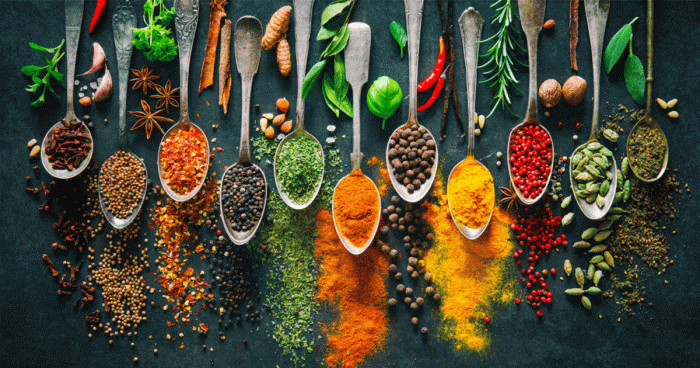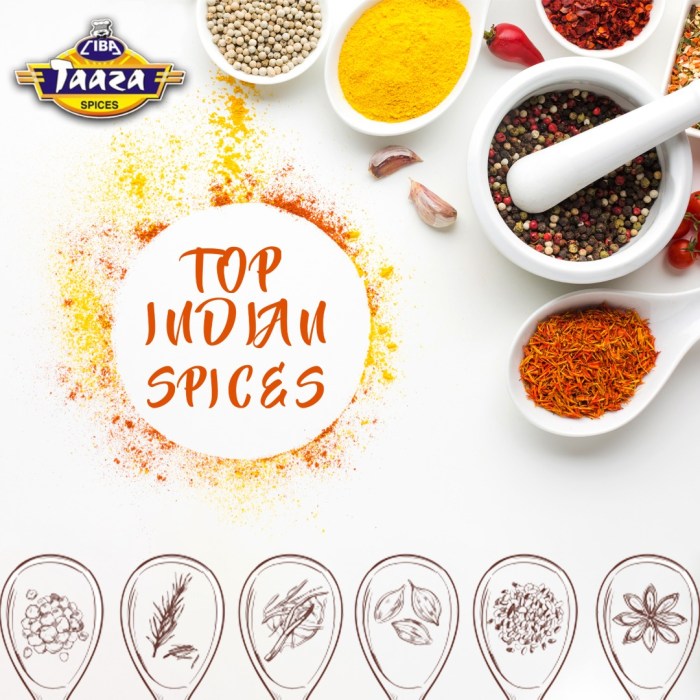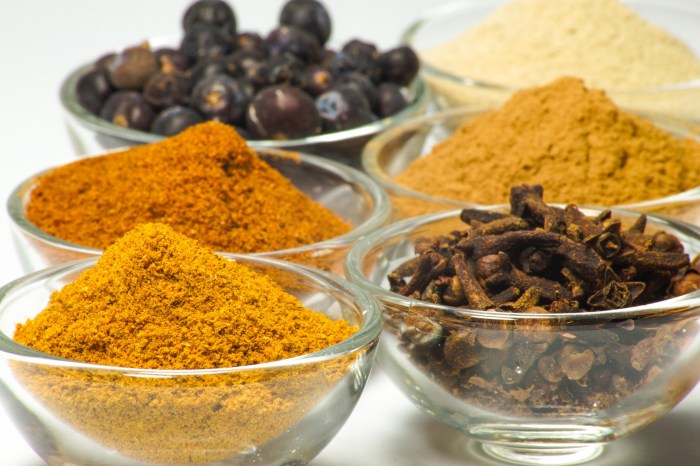Embark on a flavorful journey with How to Cook with Spices: 25 Essential Spices and Their Uses, delving into the world of spices that elevate dishes to new heights.
Discover the essence of each spice, learn about their unique flavor profiles, and unravel the culinary treasures they hold.
Introduction to Spices

Spices are aromatic or pungent substances obtained from the seeds, bark, roots, fruits, or other parts of plants. They are essential in cooking as they add flavor, color, and aroma to dishes, enhancing the overall taste experience.
Spices differ from herbs, which are also derived from plants but are obtained from the leaves rather than other parts. Herbs are typically used fresh or dried, while spices are usually dried and ground before use.
Examples of Commonly Used Spices
- Pepper: A staple in many cuisines, black pepper adds heat and flavor to dishes.
- Cumin: Widely used in Indian, Middle Eastern, and Mexican cuisine, cumin has a warm, earthy flavor.
- Paprika: This spice comes in various forms such as sweet, smoked, or hot and is commonly used in Spanish and Hungarian dishes.
Essential Spices and Their Uses

In cooking, spices play a crucial role in enhancing the flavors of dishes. Let’s explore 25 essential spices and their uses.
Cinnamon
Cinnamon is a sweet and warm spice commonly used in both sweet and savory dishes. It is widely used in Indian, Middle Eastern, and North African cuisines.
Cumin
Cumin has a warm and earthy flavor profile. It is a staple spice in Mexican, Indian, and Middle Eastern dishes, adding depth and richness to the flavor.
Paprika
Paprika can be sweet, spicy, or smoked, depending on the variety. It is commonly used in Spanish, Hungarian, and Indian cuisines to add color and flavor to dishes.
Turmeric
Turmeric has a warm and slightly bitter taste. It is a key ingredient in Indian and Southeast Asian dishes, known for its vibrant yellow color and health benefits.
Ginger
Ginger has a spicy and slightly sweet flavor. It is used in Asian, Indian, and Caribbean cuisines to add a zingy kick to dishes, both savory and sweet.
Cayenne Pepper
Cayenne pepper is hot and spicy, adding heat to dishes. It is commonly used in Mexican, Cajun, and Indian cuisines to bring a fiery kick to recipes.
Coriander
Coriander has a citrusy and slightly earthy flavor. It is a versatile spice used in cuisines worldwide, including Indian, Mexican, and Middle Eastern dishes.
Cardamom
Cardamom is sweet and floral with a hint of spice. It is a popular spice in Indian, Scandinavian, and Middle Eastern cuisines, used in both sweet and savory dishes.
Nutmeg
Nutmeg has a warm and nutty flavor. It is commonly used in baking, as well as in savory dishes like soups and stews, in cuisines around the world.
Chili Powder
Chili powder is a blend of various spicy peppers. It is a key ingredient in Mexican, Tex-Mex, and Southwestern cuisines, adding heat and flavor to dishes.
Black Pepper
Black pepper is pungent and spicy, adding heat to dishes. It is a universal spice used in cuisines worldwide to season and enhance the flavor of dishes.
Mustard Seeds
Mustard seeds have a sharp and tangy flavor. They are used in Indian, European, and African cuisines, adding a unique kick to dishes like curries and pickles.
Vanilla
Vanilla is sweet and aromatic, used in baking and desserts. It is a staple spice in Western cuisines, adding a rich and sweet flavor to cakes, cookies, and pastries.
Curry Powder
Curry powder is a blend of various spices like cumin, coriander, and turmeric. It is commonly used in Indian, Thai, and Caribbean cuisines to add depth and flavor to curries and stews.
Fennel Seeds
Fennel seeds have a sweet and licorice-like flavor. They are used in Indian, Italian, and Middle Eastern cuisines, adding a unique taste to dishes like sausages and bread.
Thyme
Thyme has a warm and earthy flavor. It is a versatile herb used in Mediterranean, French, and Caribbean cuisines to add a savory touch to dishes like roasted meats and vegetables.
Bay Leaves
Bay leaves have a subtle and herbal flavor. They are used in Mediterranean, Indian, and Caribbean cuisines to add depth and aroma to soups, stews, and sauces.
Rosemary
Rosemary has a pine-like and citrusy flavor. It is a popular herb in Mediterranean and European cuisines, used to season roasted meats, potatoes, and bread.
Saffron
Saffron is sweet and floral with a subtle earthy taste. It is a prized spice in Spanish, Indian, and Middle Eastern cuisines, known for its vibrant color and fragrance.
Star Anise
Star anise has a strong licorice-like flavor. It is used in Chinese, Vietnamese, and Indian cuisines to add a unique taste to dishes like braised meats and soups.
Caraway Seeds
Caraway seeds have a warm and slightly bitter taste. They are used in European, Middle Eastern, and Indian cuisines, adding a distinctive flavor to dishes like rye bread and sauerkraut.
Smoked Paprika
Smoked paprika has a rich and smoky flavor. It is commonly used in Spanish, Hungarian, and American cuisines to add depth and a smoky aroma to dishes like paella and barbecue.
Juniper Berries
Juniper berries have a piney and slightly citrusy flavor. They are used in Scandinavian, German, and Eastern European cuisines to add a unique taste to dishes like sauerkraut and game meats.
Sumac
Sumac has a tangy and citrusy flavor. It is used in Middle Eastern, Mediterranean, and North African cuisines to add a zesty and tart flavor to dishes like salads and grilled meats.
Chinese Five Spice
Chinese five spice is a blend of five spices like star anise, cloves, and cinnamon. It is used in Chinese, Vietnamese, and Taiwanese cuisines to add a bold and aromatic flavor to dishes like stir-fries and braised meats.
Cooking Techniques with Spices

Spices are not only essential for adding flavor to dishes but also for enhancing the overall culinary experience. There are various techniques that can be used to make the most out of spices in cooking. Let’s explore some of these methods and how they can elevate your dishes.
Dry Roasting Spices
Dry roasting spices is a common technique used to intensify their flavors. Simply heat a pan over low to medium heat and add whole spices. Toast them until fragrant, stirring constantly to prevent burning. This process helps release essential oils and deepen the taste of the spices.
Tempering Spices
Tempering is a technique where whole or ground spices are added to hot oil or ghee to release their flavors. This method is often used in Indian cooking to infuse dishes with aromatic spices. Heat the oil, add the spices, and allow them to sizzle before incorporating them into your recipe.
Layering Flavors with Spices
Balancing and layering flavors using spices is key to creating complex and delicious dishes. Start with milder spices like cumin or coriander as a base, then add bolder spices like chili powder or garam masala for depth. Experiment with different combinations to find the perfect balance for your palate.
Recipes Showcasing Versatile Uses of Spices
Spices can completely transform a dish and take it to the next level. From aromatic curries to spicy marinades, there are countless ways to showcase the versatile uses of spices in cooking. Try recipes like Chana Masala, Tandoori Chicken, or Moroccan Spiced Lamb to experience the magic of spices firsthand.
Epilogue

As we conclude our exploration of How to Cook with Spices: 25 Essential Spices and Their Uses, remember that the key to extraordinary cooking lies in the artful use of these aromatic treasures.